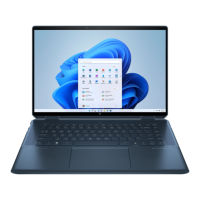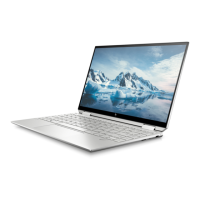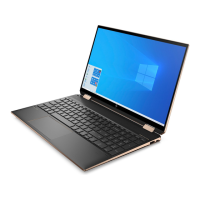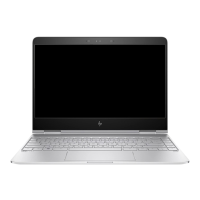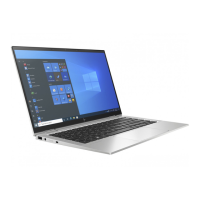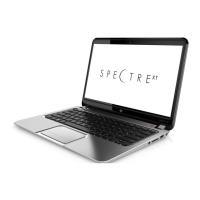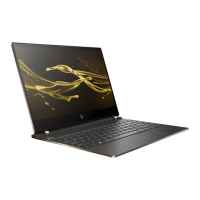Do you have a question about the HP Spectre Pro x360 G2 and is the answer not in the manual?
Guides on finding hardware components installed on the computer.
Instructions to identify installed software applications on the computer.
Identifies external and internal display components and their functions.
Explains the function of various keys on the keyboard, including action keys.
Details the status indicators (lights) on the computer and their meanings.
Describes the audio output components and their basic function.
Explains the functionality of the touchpad and its buttons.
Identifies and describes components located on the left side of the computer.
Identifies and describes components located on the right side of the computer.
Explains how to find the serial, product, and model numbers on the computer.
Illustrates the major internal components of the computer with corresponding numbers.
Lists various additional or accessory parts for the computer with their numbers.
Lists the necessary tools for performing component removal and replacement.
Provides general advice and precautions for disassembly and assembly procedures.
Warns about handling plastic parts carefully to avoid damage during service.
Advises on careful handling of cables and connectors to prevent damage during service.
Explains electrostatic discharge (ESD) and how to prevent it during service.
Provides guidelines for safely packaging and transporting electronic equipment.
Outlines recommendations for setting up a safe and effective service workstation.
Details steps to unlock the device and disable Always On Remote Management feature.
Step-by-step instructions for removing and replacing the computer's bottom cover.
Provides instructions for safely removing and replacing the laptop battery.
Step-by-step guide for removing and replacing the Wireless LAN module.
Instructions for removing and replacing the solid-state drive (SSD).
Details the procedure for removing and replacing the internal cooling fan.
Step-by-step instructions for removing and replacing the computer speakers.
Guide for removing and replacing the touchpad assembly.
Instructions for removing and replacing the card reader board.
Detailed steps for removing and replacing the main system board.
Procedure for removing and replacing the heat sink assembly.
Instructions for removing and replacing the keyboard.
Step-by-step guide for removing and replacing the entire display assembly.
Instructions for removing and replacing the audio jack board.
Procedure for removing and replacing the power connector cable.
Instructions on how to enter the BIOS Setup Utility on the computer.
Guidance on how to update the BIOS firmware for the computer.
Steps to find out the current version of the BIOS installed on the system.
Instructions on how to download BIOS updates from the HP website.
Explains the process of synchronizing keyboard firmware with the tablet.
Guide on initiating the HP PC Hardware Diagnostics tool.
Instructions to download the diagnostic tool onto a USB drive.
Provides the physical dimensions of the computer in metric and U.S. units.
Details the operating voltage and current requirements for the computer.
Specifies the operating and non-operating temperature ranges for the device.
Lists the acceptable ranges for operating and non-operating relative humidity.
Indicates the maximum altitude at which the computer can operate safely.
Instructions on creating system recovery media and personal data backups.
Detailed steps for creating HP-specific recovery media.
Outlines various options for restoring the system to a previous state.
Explains how to use built-in Windows tools for backups and restore points.
Guide on using HP Recovery Manager for system recovery and factory reset.
Instructions for performing system recovery using the dedicated recovery partition.
Steps to recover the system using created HP Recovery media.
How to modify the boot order for startup device selection.
Instructions on how to remove the recovery partition to free up disk space.
Details non-volatile memory types, their usage, and data retention properties.
Provides answers to common questions regarding BIOS and system configuration.
Information about the HP Sure Start feature for BIOS protection.
Outlines the general requirements for power cord sets applicable worldwide.
Lists specific power cord set requirements and certifications for various countries.
Guides on finding hardware components installed on the computer.
Instructions to identify installed software applications on the computer.
Identifies external and internal display components and their functions.
Explains the function of various keys on the keyboard, including action keys.
Details the status indicators (lights) on the computer and their meanings.
Describes the audio output components and their basic function.
Explains the functionality of the touchpad and its buttons.
Identifies and describes components located on the left side of the computer.
Identifies and describes components located on the right side of the computer.
Explains how to find the serial, product, and model numbers on the computer.
Illustrates the major internal components of the computer with corresponding numbers.
Lists various additional or accessory parts for the computer with their numbers.
Lists the necessary tools for performing component removal and replacement.
Provides general advice and precautions for disassembly and assembly procedures.
Warns about handling plastic parts carefully to avoid damage during service.
Advises on careful handling of cables and connectors to prevent damage during service.
Explains electrostatic discharge (ESD) and how to prevent it during service.
Provides guidelines for safely packaging and transporting electronic equipment.
Outlines recommendations for setting up a safe and effective service workstation.
Details steps to unlock the device and disable Always On Remote Management feature.
Step-by-step instructions for removing and replacing the computer's bottom cover.
Provides instructions for safely removing and replacing the laptop battery.
Step-by-step guide for removing and replacing the Wireless LAN module.
Instructions for removing and replacing the solid-state drive (SSD).
Details the procedure for removing and replacing the internal cooling fan.
Step-by-step instructions for removing and replacing the computer speakers.
Guide for removing and replacing the touchpad assembly.
Instructions for removing and replacing the card reader board.
Detailed steps for removing and replacing the main system board.
Procedure for removing and replacing the heat sink assembly.
Instructions for removing and replacing the keyboard.
Step-by-step guide for removing and replacing the entire display assembly.
Instructions for removing and replacing the audio jack board.
Procedure for removing and replacing the power connector cable.
Instructions on how to enter the BIOS Setup Utility on the computer.
Guidance on how to update the BIOS firmware for the computer.
Steps to find out the current version of the BIOS installed on the system.
Instructions on how to download BIOS updates from the HP website.
Explains the process of synchronizing keyboard firmware with the tablet.
Guide on initiating the HP PC Hardware Diagnostics tool.
Instructions to download the diagnostic tool onto a USB drive.
Provides the physical dimensions of the computer in metric and U.S. units.
Details the operating voltage and current requirements for the computer.
Specifies the operating and non-operating temperature ranges for the device.
Lists the acceptable ranges for operating and non-operating relative humidity.
Indicates the maximum altitude at which the computer can operate safely.
Instructions on creating system recovery media and personal data backups.
Detailed steps for creating HP-specific recovery media.
Outlines various options for restoring the system to a previous state.
Explains how to use built-in Windows tools for backups and restore points.
Guide on using HP Recovery Manager for system recovery and factory reset.
Instructions for performing system recovery using the dedicated recovery partition.
Steps to recover the system using created HP Recovery media.
How to modify the boot order for startup device selection.
Instructions on how to remove the recovery partition to free up disk space.
Details non-volatile memory types, their usage, and data retention properties.
Provides answers to common questions regarding BIOS and system configuration.
Information about the HP Sure Start feature for BIOS protection.
Outlines the general requirements for power cord sets applicable worldwide.
Lists specific power cord set requirements and certifications for various countries.
| Form factor | Convertible (Folder) |
|---|---|
| Product type | Hybrid (2-in-1) |
| Product color | Silver |
| Country of origin | China |
| Motherboard chipset | Intel SoC |
| Numeric keypad | No |
| Pointing device | Touchpad |
| Full-size keyboard | Yes |
| Internal memory | 8 GB |
| Memory clock speed | 1600 MHz |
| Internal memory type | LPDDR3-SDRAM |
| Memory layout (slots x size) | 1 x 8 GB |
| SSD capacity | The Solid State Drive's storage capacity in Gigabytes. |
| SSD interface | M.2, SATA |
| Storage media | SSD |
| Total storage capacity | 256 GB |
| Compatible memory cards | SD, SDHC, SDXC |
| Number of SSDs installed | 1 |
| Operating system architecture | 64-bit |
| Display surface | Gloss |
| Display diagonal | 13.3 \ |
| Touch technology | Multi-touch |
| Touchscreen type | Capacitive |
| Native aspect ratio | 16:9 |
| On-board graphics card ID | 1916 |
| Discrete graphics card model | Not available |
| On-board graphics card model | Intel® HD Graphics 520 |
| On-board graphics card family | Intel® HD Graphics |
| Maximum on-board graphics card memory | 1.74 GB |
| On-board graphics card OpenGL version | 4.4 |
| On-board graphics card base frequency | 300 MHz |
| On-board graphics card DirectX version | 12.0 |
| On-board graphics card dynamic frequency (max) | 1000 MHz |
| Battery capacity | 56 Wh |
| Number of battery cells | 3 |
| Intel segment tagging | Home Office, Small Business |
| Number of built-in speakers | 2 |
| WWAN | Not installed |
| Wi-Fi standards | 802.11a, 802.11b, 802.11g |
| Bluetooth version | 4.2 |
| Top Wi-Fi standard | Wi-Fi 4 (802.11n) |
| Charging port type | DC-in jack |
| USB 2.0 ports quantity | 0 |
| Bus type | QPI |
| Stepping | D1 |
| Tjunction | 100 °C |
| Processor cache | 3 MB |
| System bus rate | 4 GT/s |
| Processor family | Intel® Core™ i5 |
| Processor series | Intel Core i5-6200 series |
| Processor socket | LGA 1356 (Socket B2) |
| Processor threads | 4 |
| Processor codename | Skylake |
| Configurable TDP-up | 25 W |
| Processor frequency | 2.3 GHz |
| Processor cache type | Smart Cache |
| Configurable TDP-down | 7.5 W |
| Processor lithography | 14 nm |
| Processor manufacturer | Intel |
| Processor front side bus | - MHz |
| PCI Express slots version | 3.0 |
| Processor boost frequency | 2.8 GHz |
| PCI Express configurations | 1x4, 4x1 |
| Thermal Design Power (TDP) | 15 W |
| Configurable TDP-up frequency | 2.4 GHz |
| Configurable TDP-down frequency | 0.8 GHz |
| Maximum number of PCI Express lanes | 12 |
| Processor code | SR2EY |
| Processor ARK ID | 88193 |
| Processor package size | 42 X 24 mm |
| Supported instruction sets | SSE4.1, SSE4.2, AVX 2.0 |
| Intel Smart Response Technology version | 1.00 |
| Intel Stable Image Platform Program (SIPP) version | 0.00 |
| AC adapter power | 45 W |
| AC adapter frequency | 50 - 60 Hz |
| AC adapter input voltage | 100 - 240 V |
| AC adapter output voltage | 19 V |
| Sustainability certificates | RoHS, EPEAT Silver, ENERGY STAR |
| HP segment | Business |
| HP Software provided | HP Wireless Hotspot |
| Depth | 218 mm |
|---|---|
| Width | 325 mm |
| Height | 15.4 mm |
| Weight | 1480 g |
